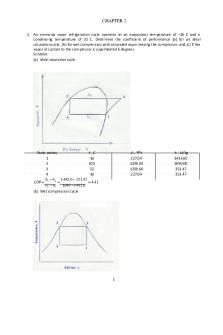Copy of Chapter 02 Review PDF

| Title | Copy of Chapter 02 Review |
|---|---|
| Author | Mitch Wolford |
| Course | Introduction to Business |
| Institution | Oakland Community College |
| Pages | 3 |
| File Size | 42.3 KB |
| File Type | |
| Total Downloads | 47 |
| Total Views | 146 |
Summary
Questions from chapter 2 of the textbook...
Description
Mitch Wolford Intro to Business Chapter 02 Economics: The Framework for Business 1. How did the global economic crisis unfold? ●
The last half of the 1990s America enjoyed unprecedented growth. Than the dotcom bubble burst in 2000, followed by the 9/11 “terrorist” attacks. The stock market dropped and unemployment rose.
2. What steps did the federal government and the federal reserve take to mitigate the crisis? ●
The Federal reserve decreased interest rates from 6.5% in mid-2000 to 1,25% by the end of 2002.
3. Compare and contrast microeconomics and macroeconomics. How do the two approaches interrelate? Use a specific example to explain. ●
Macroeconomics deals with country’s overall economic dynamics such as the employment rate, while microeconomics deals with the smaller economic units such as individual consumers and businesses. Aggregate production and consumption levels are the result of choices made by individual households and businesses. Supply and demand is an example because both branches look at how changes in either supply or demand affect and impact the other.
4. What is the difference between fiscal and monetary policy? What role does politics play in shaping these policies? ●
Monetary involves changing the interest rate and influencing the money supply, while fiscal involves the government changing tax rates and levels of government spending to influence aggregate demand in the economy. Politics play a role by making taxes higher and by influencing interest rates.
5. What are the fundamental elements of the free market economic system? How can
businesses thrive within this system? ●
The right to own a business and keep after-tax profits, the right to private property, the right to free choice, and the right to fair competition. Businesses can thrive by profiting from these by getting extra money after taxes by owning their own property.
6. Describe the difference between a monopolistic competition and a monopoly. ●
A monopolistic competition is a market structure with many competitors selling different products, while a monopoly is a market structure with one producer completely dominating the industry.
7. Why does quantity supplied tend to increase when prices go up and decrease when prices go down? Why does quantity demanded move in the opposite direction? ●
Because if there isn't any competition, customers will buy it. If there is competition the prices have to go down to sell it and there isn't as many because other businesses are making money to and they may not want to overstock. There is sometimes competition, and sometimes there is not.
8. Describe the key principles of socialist and communist economy systems. Does more government control mean less economic opportunity? Why or why not? ●
Socialism is based on the principle that the government should own and operate key enterprises that directly affect public welfare, while communism is based on the principle that calls for public ownership of virtually all enterprises , under the direction of a strong central government. Less economic opportunity, because, for example they can control how much healthcare one could get.
9. Why do most countries have neither “pure” market nor “pure” planned economies? Is the trend toward the market end of the spectrum likely to continue? Why? ●
Because it would make insufficient provision for the old, the young, the sick, and the environment. A pure planned economy would not create enough value to support their people over the long term. Yes, so corruption can be cut down and
so economic rights can be protected. 10. How do gross domestic product, the employment rate, and the inflation rate relate to the business cycle? Why is it difficult to predict changes in the business cycle? ●
Because they are all always changing. It is difficult to predict changes in the business cycle because there are always changes going on whether they are for the good or the bad....
Similar Free PDFs

Copy of Chapter 02 Review
- 3 Pages

Copy of Fortinberry 1 - Review
- 45 Pages

Principles Of Economics Chapter 02
- 32 Pages

Copy of Chapter 11 Notes
- 20 Pages

Copy of AP LANG EXAM Review
- 9 Pages

Review article notes - Copy
- 15 Pages

Exam Review 02
- 9 Pages

Chapter 02
- 13 Pages

Chapter 02
- 10 Pages

Chapter 02
- 47 Pages

Chapter 02
- 14 Pages
Popular Institutions
- Tinajero National High School - Annex
- Politeknik Caltex Riau
- Yokohama City University
- SGT University
- University of Al-Qadisiyah
- Divine Word College of Vigan
- Techniek College Rotterdam
- Universidade de Santiago
- Universiti Teknologi MARA Cawangan Johor Kampus Pasir Gudang
- Poltekkes Kemenkes Yogyakarta
- Baguio City National High School
- Colegio san marcos
- preparatoria uno
- Centro de Bachillerato Tecnológico Industrial y de Servicios No. 107
- Dalian Maritime University
- Quang Trung Secondary School
- Colegio Tecnológico en Informática
- Corporación Regional de Educación Superior
- Grupo CEDVA
- Dar Al Uloom University
- Centro de Estudios Preuniversitarios de la Universidad Nacional de Ingeniería
- 上智大学
- Aakash International School, Nuna Majara
- San Felipe Neri Catholic School
- Kang Chiao International School - New Taipei City
- Misamis Occidental National High School
- Institución Educativa Escuela Normal Juan Ladrilleros
- Kolehiyo ng Pantukan
- Batanes State College
- Instituto Continental
- Sekolah Menengah Kejuruan Kesehatan Kaltara (Tarakan)
- Colegio de La Inmaculada Concepcion - Cebu




